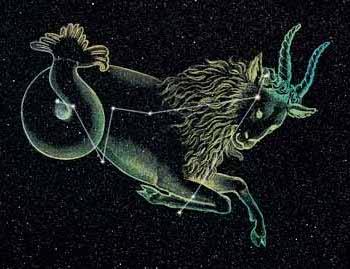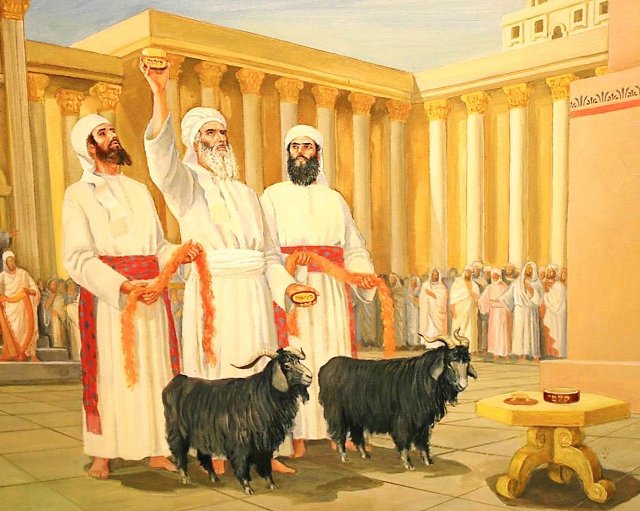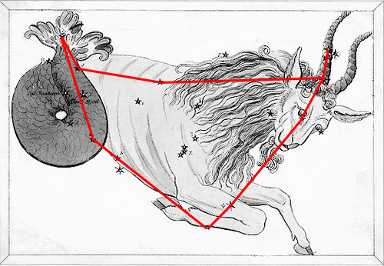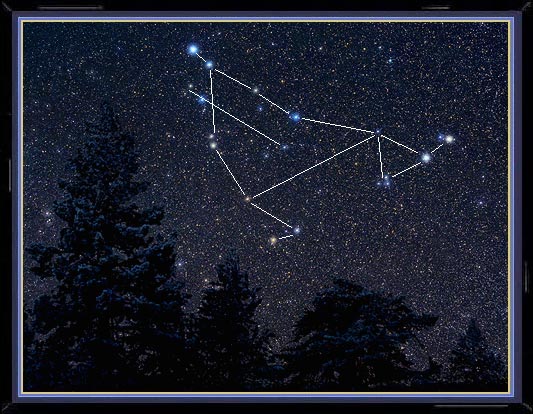
by John P. Pratt
Good Friday, 25 Mar 2016
©2016 by John P. Pratt. All rights Reserved.
| 1. Two Goats |
| 2. Why a Fish Tail? |
| 3. New Evidence: The Thorn |
| 4. Conclusion |
| Notes |
This article is one in a series attempting to restore the twelve zodiac constellations to their original forms.[1] The importance of this restoration is that there is compelling evidence that the constellations were originally revealed to the Prophet Enoch as representing deep truths of the gospel of Jesus Christ. This article focuses on the constellation of Capricornus. Newly discovered evidence that it has a hitherto overlooked thorn in its side is presented along with a proposed interpretation that the thorn helps identify the goat as Jesus Christ being crucified because he was mistaken for a goat rather than being the Lamb of God.
 |
Most of the books which review traditions that the constellations were drawn by the Prophet Enoch to represent the gospel propose that the Sea-Goat represents two aspects of Jesus Christ: that He (1) died as a sacrifice, as the goat sacrificed on the Day of Atonement, and later (2) resurrected full of life as represented by a fish.[2] Both of those interpretations raise questions. First, Jesus was known as the Lamb of God, not the Goat of God. In fact, Jesus used goat symbolism to represent evil (Mat. 25:33). So why should we think that the goat represents Christ? Moreover, why should a fish represent resurrection? Usually the fish represents the Church of Christ. In the other fish constellations of the Fishes (Pisces) and the Southern Fish (Piscis Austrinus), fish represent Christians or the followers of Christ.[3] Even though it all sounded somewhat forced to me, my earlier articles followed their lead for lack of a better suggestion.[4] To me it has never been clear what the Sea-Goat was really all about, but it almost certainly represented a dying goat because some of the star names referred to it being "slaughtered".[5] This article announces the recent discovery that the goat has a thorn in its side which could be the hitherto overlooked detail which is the key to understanding the important gospel meaning of this constellation.
In order to understand the subtleties of the interpretation proposed in this article, let us first review the rites performed in the law of Moses on the Day of Atonement to understand why a goat, rather than a lamb, might represent Christ.
On the Day of Atonement in the autumn of each year, the law of Moses prescribed an unusual ritual. It has been described in detail in an earlier article,[6] but it bears reviewing briefly here.
Perhaps it should first be noted that many treatments of this rite are both superficial and incorrect. This is the ritual which involves the scapegoat. If you have ever heard any about the origin of the word "scapegoat", it is probably that the Hebrews placed the burden of all sin on the scapegoat. Hence it "obviously" represented Jesus Christ and it was sacrificed to atone for our sins. That is not true; there were two goats and the other one was sacrificed to atone for our sins. So let us look at it more deeply, especially seeking to understand why goats were used at all.
 |
Even after reviewing the ritual, the meaning is still not clear. Why were goats used? Why two goats instead of one? Why do they both seem to bear the burden of our sins? Why is one sent away? What is going on here that it is so important to be the main ritual performed on the Day of Atonement, the holiest day of the Hebrew year?
The key to understand the overall purpose and meaning is something that is understood by modern Hebrews[8] and was understood by early Christians who had the Book of Enoch. That is a book which was accepted at the time of Christ as authentic (actually written by the Prophet Enoch) and Jesus quoted from it often.[9] It was in the collection of sacred books that became the Bible until it was rejected by the Council of Nicea in AD 325 because it sounded just a little too weird. From Enoch we learn that Azazel is one of the names of Satan. That goat is a symbol of Satan! One of his names is the "Banished Goat" because he was cast out of heaven.
Armed with that knowledge, let's look at the ritual anew. One goat represents Satan so the use of a goat is expected. That goat carries the burdens of the people's sin because he is the author of sin and rebellion against God. He is the problem, not the solution. The fits with the popular meaning of "scapegoat": he is the one blamed for the problems. Thus he is banished. The other goat represents Jehovah, the Lord, who was to come in the flesh as Jesus Christ to redeem His people (Mosiah 15:1). He is the one who fixes the problem by being sacrificed to atone for sins. That part is now seen to be very simple and it was obviously intended to be easily understood because the scapegoat was tagged with the name of Satan, which everyone knew, and the other with the name of Jehovah.
But what about Jesus also being represented not only by a goat, but also by one that looks virtually identical to Satan? There is clearly a very important message in that symbolism. What is it? Surely it is that sometimes Christ and Satan can look so much like each other that it is difficult to decide which is which.
A moment's reflection again makes that clear. To the unrighteous, the Savior often appeared to be evil, and hence is represented as a goat because that is how He would be judged by many. He was often accused of breaking the law of Moses, such as healing on the sabbath. When He performed miracles, many accused Him of doing them by the power of Satan. When He said He was the Son of God He was accused of blasphemy and was crucified with other criminals. The same is the case with His messengers, the true prophets. The most standard treatment of them was to execute them as impostors, as false prophets. Usually the only evidence against them was that they claimed that the people were wicked and needed to repent. Those hearing that message "knew" they were righteous so it was an open and shut case that the man was a false prophet.
This is a fundamental gospel principle. Satan is the great impostor who often claims to be the Christ, the Firstborn and the Savior. He promises things very much like what the Savior does. He attempts to appear exactly like the Savior and can appear as an angel of light. Instead of providing freedom and happiness, however, his shortcut methods turn out to be lies and to lead to misery and captivity. Without the name tags, it is almost impossible to distinguish between Christ and Satan.
This Scapegoat Pattern is truly one of the core concepts of the gospel of Jesus Christ. Consider three historical examples. In the pre-existence two chosen sons of God stood before the Father. After Jesus volunteered to be the Savior, saying "Here am I, send me", Satan immediately followed using the identical words (Abr. 3:27). Both favored obedience to God so both of their plans may have sounded similar. Their fate was in the Father's hands to choose between them. The first became the Savior and the second was banished.
 |
A final example is the coming Anti-Christ. He will appear to be so good, promising a world of peace and prosperity, that most will follow him. Many will believe that he is the returned Christ, but he will be the counterfeit. Each of us stands in the place of the priest to choose between a true and a false prophet. That time is now arriving for us to choose because there are now many voices claiming to be in contact with God. (Search the Internet if you are not aware of that!) Distinguishing Christ from Satan is one of our core tests on earth. Anyone who believes it easy to recognize a true prophet from a false one may be in for a surprise. Remember that Israel usually rejected any true prophet as an impostor because they "knew" that they were righteous and he said they weren't. It is a concept so important that it merits one of the twelve zodiac constellations to represent it.
The meaning of Azazel to refer to Satan is a "plain and precious" part of the Bible, removed after the death of the apostles, which has truly caused people to stumble (1 Nephi 13:29) in understanding this ritual. When that is known, the whole ritual is much easier to understand.
 |
So what about the fish tail? Let me begin by saying that it is not clear to me that the fish tail is part of the original constellation at all. It is said that the Sea-Goat representation goes back to very ancient times, at least to ancient Babylon. There are several reasons for believing Capricornus originally did not have a fish tail.
First, the principal source of our knowledge of the constellation is from the detailed descriptions by the Greek astronomer Ptolemy (AD 150) who left us a star catalog which identified exactly which star was at what part of the figure. Nearly every star map which shows the ancient constellations is based on his catalog. He refers to the constellation as "the Goat" and nowhere does he refer to any part of it as looking like a fish. The name Capricornus means "Horned Goat" in Latin and Ptolemy simply refers to it as a goat. The poet Aratus (250 BC) who described all of the constellations in a poem based on the work of the earlier astronomer Eudoxus (370 BC) also makes no mention of any fish tail. He refers to the constellation in Greek with the same meaning as the modern Roman name: "Horned Goat". Nearly all goats have horns but none have fish tails, so that seems like a poor name for a Sea-Goat. To me, the only evidence that it is a sea-goat is that there is no description of any hind legs. But absence of evidence for hind legs is not evidence of absence of hind legs, so that proves nothing. There are several constellations that don't have stars in the area where legs are, but that does not mean they are legless. For example most of the legs of the Scorpion and Crab have no stars listed in them.
 |
If the fish tail is authentic and if the meaning of the goat is that it is Christ being the Great Sacrifice, then the fish tail could be intended to be another sign that this is really Christ. That is, the fish is the symbol of Christians, followers of Christ. Presumably Jesus himself could be considered to be in that group too, that is, He could be considered to be a Christian and hence represented by a fish. To me that seems a little forced but it appears to be the most likely explanation at this point.
If that is correct, it could also be that the original was a goat and someone who understood it changed the posterior to be a fish to make it more obvious that the figure represents Christ (the fish) who was mistakenly identified as a goat and was slain. Some ancient artists changed a constellation to make it more clear what it stood for. For example, sometimes the two fishes in the Fishes (Pisces) were drawn with the heads of women.[11] The woman or bride is also a symbol of the church of Christ, so a fish with a woman's head might help make that more obvious to those who are familiar with the symbolism that the fish represented Christians. Similarly, someone might have changed the goat into a Sea-Goat to make it more clear that this goat represented Christ rather than Satan.
Let us then consider the hypothesis that the Sea-Goat represents Christ (the fish half) but is mistaken for Satan (the goat half). Hence He was slain as a criminal along with two thieves. Let us turn to the new evidence which supports this interpretation.
There is an important factor which to my knowledge has been totally overlooked until now in all illustrations of the Sea-Goat. Ptolemy identifies two stars as being at one end of a "thorn" in the side of the goat. Astronomers and artists alike tend to drop undesirable features out of pictures and it looks like no artist saw a reason to put a thorn in the side of the goat. That thorn, however, may be the "name tag" which is required to identify just who the goat is.
 |
It would not work well to have the constellation of the Sea-Goat have nail marks in its hooves to identify it. Those would neither be noticed nor understood. But what about the mark of the spear in His side? At the Crucifixion, the Savior's body was pierced in the side with a spear. That was not just a random act because John testified that it was the piercing referred to by the prophet Zechariah referring to the Second Coming: "And again another scripture saith, They shall look on him whom they pierced" (John 19:37 quoting Zech. 12:10). That is, the mark of the spear was not just a convenient surprise wound which Jesus could also use for the powerful identification effect by having someone thrust his hand into His side. It had been prophesied long before by Zechariah that at the time of the Second Coming that His piercing will again be used as an identifying mark. The piercing referred to by Zechariah was from the spear, not from the nails.
This new discovery has been in front of (some of) us all the time, but as far as is known to me it has been entirely overlooked until now. Ptolemy identifies the two stars shown at the left end of the spear in the stick figure illustration as being at one end of "the thorn".[12] The Greek word translated "thorn" is not known to me, but the "thorn" must have been large to have those two stars be located at just one end of it. The location of the other end is not specified. The suggested location for other end is at the three stars at the center of the side of the body, which seem like the most logical place. Those three stars could represent His wound. Thus, my proposed interpretation of the "thorn" is that it is a spear, in fact, it is the spear that was thrust into the side of the Savior while on the cross.
Thus, the interpretation of the gospel message of Capricornus is that he represents Jesus Christ being sacrificed to pay for our sins. It is important to remember that He was executed because He had been judged to have been an evil false prophet, so He is represented by a goat and identified by the spear.
The gospel meaning of the zodiac constellation Capricornus has never been totally clear. Most have suggested that he represents the Great Sacrifice of the Savior, but questions have remained unanswered, such as why a goat would be used to represent the Lamb of God. This article agrees with others that it is the goat from the ritual performed in the law of Moses on the Day of Atonement in which Jehovah is represented by a goat. This article adds that the reason for using a goat is that Christ can easily be mistaken for Satan. Indeed that happened at His Crucifixion when Jesus was executed as a criminal, not (knowingly) as a holy sin offering. The recent discovery that Capricornus has a "thorn" in its side is interpreted to be the spear which pierced the Savior's body on the cross. This sign of His identity is taken as intended to identify Capricornus as representing the atonement and sacrifice of Jesus Christ.